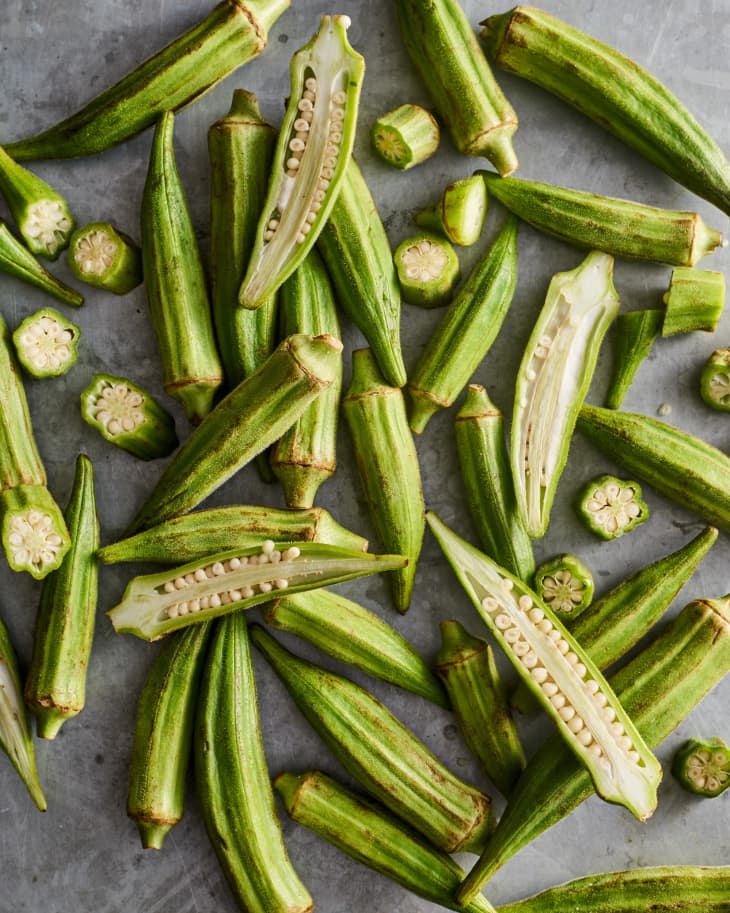Okra: The Best Ways to Pick It, Cook It, and Eat It
Don’t let okra’s reputation as a slimy soup-filler in Southern stews dissuade you: This farmers market fave can get downright crunchy or be pleasingly tender, given the right preparation. And for the texturally adventurous, there are dozens of ways to take full advantage of the more mucilaginous properties in side dishes, salads, and even, yes, soups and stews.
What Is Okra?
Okra, also called Lady’s Fingers, are the young, edible seed pods of a six-foot flowering plant related to cotton and hibiscus. Botanically a fruit (because it contains the seeds), okra is used culinarily as a vegetable in cuisines around the world, but predominately in India, Africa, the Caribbean, parts of South America, and the American South.
The Okra Top 5
Five must-reads for those ready to see just what this little green seed pod can do.
- If you want to love okra but don’t love the texture, here’s how to cook it without slime.
- A screed for all the okra-haters: Why you should give it a chance.
- One great way to use it: dried out and ground up.
- Here are five ways we love okra, including fried, pickled, and stewed.
- One of the best ways to use okra? Treat them like pickles.
How to Choose the Best Okra
Choosing good okra is, thankfully, not too difficult. The one thing to remember — especially if you’re growing your own, or buying from a farmers market — is that the younger, smaller pods are likely to be more tender and delicious. As pods mature they become woody and inedible. Otherwise, look for bright, vibrant color, a firm feel, and no signs of spotting or mold.
To keep it fresh, store in a paper bag or anything that lets a little air circulate and moisture escape, and put it in your crisper drawer. It should be good for a few days.
What Does Okra Taste Like?
It depends entirely on how you cook it! As with a variety of vegetables, the seasoning and cooking methods you use make a great deal of difference in how it tastes. Raw (yes, you can eat them raw!) they are vegetal and crunchy, with a peach-like fuzz on the exterior and just a touch of viscosity coating the seeds when you crunch into one. Fried or baked, they are crunchy and dry, and are improved drastically by a little salt and some savory spice like paprika or cumin. And when stewed with tomatoes or put into soup, their famously divisive gooey texture comes into full effect. It adds plenty of body to things like gumbo and is a distinctive, if acquired, taste.
What Are the Best Ways to Cook Okra?
One of our favorite ways to prepare okra isn’t really cooking at all — it’s pickling! It’s a method that makes the most of okra’s crunchy spears, but keeps the slime factor to a minimum. Plus, it’s not terribly difficult to do: A quick pickle takes about 20 minutes to make, and is ready within a day — although it tastes even better if you wait a couple of days.
Beyond pickling, okra is delicious roasted in the oven. All the moisture bakes off, and it comes out crispy and dry, tasting like vegetable french fries.
- Get a Recipe: How To Make Oven-Roasted Okra
Finally, if you’re feeling adventurous, okra is actually really good when it’s a little slimy. It tastes something like a vegetable version of oysters: Sweet, slippery, and uniquely vegetal. There’s a good reason so many cuisines include it, and if you can get over your initial aversion, you may find it becomes a summer staple. If you want to give it a go, here’s a classic recipe for stewed tomatoes and okra from Spicy Southern Kitchen.
What Are the Nutritional Benefits of Okra?
Okra is a fantastically nutritious food! Just one cup (about 3.5 ounces) contains 12% of your daily fiber, 38% of your vitamin C, 8% of your calcium, and 8% of your potassium needs for the day! All with just 33 calories.
How to Freeze Okra
If you went overboard in the garden or got a little greedy at the farmers market, don’t worry: While okra is definitely best prepared fresh, it’s completely freezable. You can even buy frozen okra from the store.
To freeze it, wash the produce and then blanch it for three to four minutes in boiling water. This will keep it looking and tasting its best. Cool the okra in an ice bath, then prepare it: You can leave it whole or dice it for easier frying or baking later. Spread it out evenly on a sheet pan and put the whole pan in the freezer. This will freeze it more quickly and ensure it doesn’t clump. Transfer the frozen okra to a bag, and it should keep for up to six months.
Can Dogs Eat Okra?
Is it safe for dogs to eat okra? The American Kennel Club, which weighs in authoritatively on every aspect of dog diets from kale to quinoa, is strangely silent on the subject of okra. However, dog care site Rover.com believes okra is perfectly fine for dogs — in moderation. Too much, because of the high fiber content, will cause gas.
But the real question is: Will your dog eat okra?
The Best Ways to Use Up Leftover Okra
Roll it in breading and buttermilk, and fry it!
Our Top 4 Okra Recipes
What’s your favorite recipe or use for okra? Any favorite way to cook it?
31 Days of Vegetables: How to fall in love with vegetables in 31 days. How many of these splendid veg have you eaten this month? Take a look at the whole list and take our July challenge to eat every single one!
